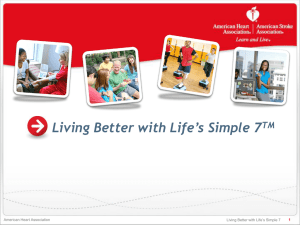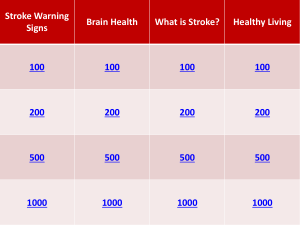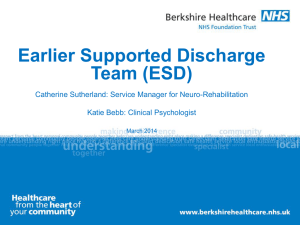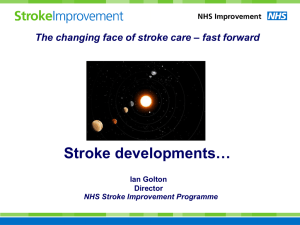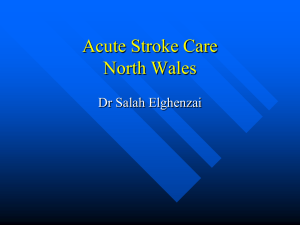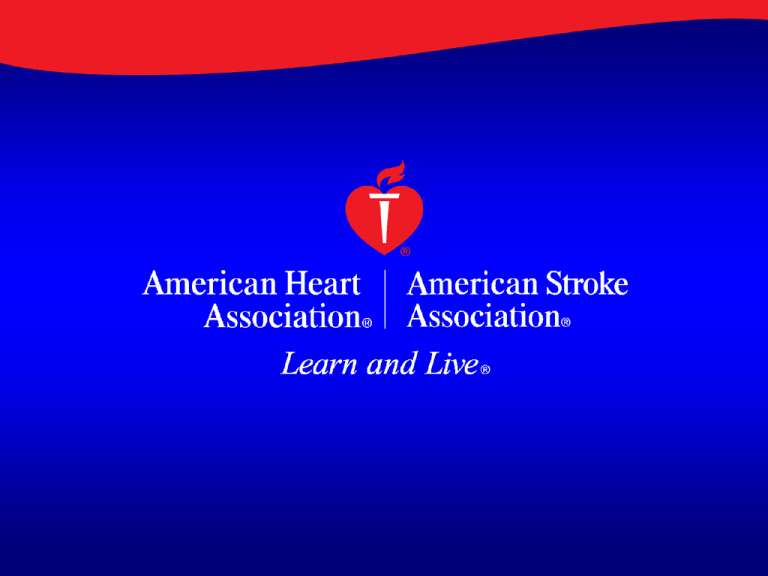
Guidelines for the Primary
Prevention of Stroke.
A Guideline for Healthcare Professionals
From the American Heart Association &
American Stroke Association
©2010 American Heart Association, Inc. All rights reserved.
Goldstein et al. Published online in Stroke Dec. 2, 2010
Writing Committee
Larry B. Goldstein, MD, FAHA, Chair; Cheryl D. Bushnell,
MD, MHS, FAHA, Co-Chair; Robert J. Adams, MS, MD,
FAHA; Lawrence J. Appel, MD, MPH, FAHA; Lynne T. Braun,
PhD, CNP, FAHA; Seemant Chaturvedi, MD, FAHA; Mark A.
Creager, MD, FAHA; Antonio Culebras, MD, FAHA; Robert H.
Eckel, MD, FAHA; Robert G. Hart, MD, FAHA; Judith A.
Hinchey, MD, MS, FAHA; Virginia J. Howard, PhD, FAHA;
Edward C. Jauch, MD, MS, FAHA; Steven R. Levine, MD,
FAHA; James F. Meschia, MD, FAHA; Wesley S. Moore, MD,
FAHA; J.V. (Ian) Nixon, MD, FAHA; Thomas A. Pearson, MD,
FAHA.
On behalf of the American Heart Association Stroke Council; Council on
Cardiovascular Nursing; Council on Epidemiology and Prevention;
Council for High Blood Pressure Research; Council on Peripheral
Vascular Disease; and Interdisciplinary Council on Quality of Care and
Outcomes Research
©2010 American Heart Association, Inc. All rights reserved.
Goldstein et al. Published online in Stroke Dec. 2, 2010
Slide Set developed by:
Deborah Bergman, RN, MSN, C-NP
Ken Uchino, MD
©2010 American Heart Association, Inc. All rights reserved.
Goldstein et al. Published online in Stroke Dec. 2, 2010
Definition of Classes and Levels of Evidence Used in AHA
Recommendations
Class I Conditions for which there is evidence for and/or general agreement that the procedure or
treatment is useful and effective.
Class II Conditions for which there is conflicting evidence and/or a divergence of opinion about the
usefulness/efficacy of a procedure or treatment.
Class IIa The weight of evidence or opinion is in favor of the procedure or treatment.
Class Iib Usefulness/efficacy is less well established by evidence or opinion.
Class III Conditions for which there is evidence and/or general agreement that the procedure or
treatment is not useful/effective and in some cases may be harmful.
Therapeutic Recommendations
Level of Evidence A Data derived from multiple randomized clinical trials or meta-analyses
Level of Evidence B Data derived from a single randomized trial or nonrandomized studies
Level of Evidence C Consensus opinion of experts, case studies, or standard of care
Diagnostic Recommendations
Level of Evidence A Data derived from multiple prospective cohort studies using a reference
standard applied by a masked evaluator
Level of Evidence B Data derived from a single grade A study, or one or more case-control
studies, or studies using a reference standard applied by an unmasked evaluator
Level of Evidence C Consensus opinion of experts
©2010 American Heart Association, Inc. All rights reserved.
Goldstein et al. Published online in Stroke Dec. 2, 2010
Well-documented
Risk Factors
•
•
•
•
•
•
•
•
•
•
•
Hypertension
Exposure to cigarette smoke
Diabetes
Atrial fibrillation and certain
other cardiac conditions
Dyslipidemia
Asymptomatic Carotid artery
stenosis
Sickle cell disease
Postmenopausal hormone
therapy
Poor diet
Physical inactivity
Obesity and body fat
distribution
©2010 American Heart Association, Inc. All rights reserved.
Less well-documented
or potentially
modifiable Risk Factors
• Metabolic syndrome
• Excessive alcohol
consumption
• Drug abuse
• Use of oral contraceptives
• Sleep-disordered breathing
• Migraine
• Hyperhomocysteinemia
• Elevated lipoprotein(a)
• Hypercoagulability
• Inflammation
• Infection
Goldstein et al. Published online in Stroke Dec. 2, 2010
Hypertension
Risk Factors
Recommendation - Hypertension
Class/Level of
Evidence
Use of existing guidelines for glycemic control and BP
targets in patients with diabetes is recommended for
patients who have had a stroke or TIA In agreement with the
JNC 7 report, regular BP screening and appropriate
treatment, including both lifestyle modification and
pharmacological therapy, are recommended.
Class I; Level of
Evidence A
Systolic BP should be treated to a goal of <140 mm Hg
and diastolic BP to <90 mm Hg because these levels are
associated with a lower risk of stroke and cardiovascular
Events.
Class I; Level of
Evidence A
In patients with hypertension with diabetes or renal disease,
the BP goal is <130/80 mm Hg.
Class I; Level of
Evidence A
©2010 American Heart Association, Inc. All rights reserved.
Goldstein et al. Published online in Stroke Dec. 2, 2010
Cigarette Smoking
Risk Factors
Recommendation – Cigarette Smoking
Class/Level of
Evidence
Abstention from cigarette smoking by nonsmokers and smoking
cessation by current smokers are recommended based on
epidemiological studies showing a consistent and overwhelming
relationship between smoking and both ischemic stroke and SAH.
Class I; Level of
Evidence B
Although data are lacking that avoidance of environmental tobacco
smoke reduces incident stroke, on the basis of epidemiological data
showing increased stroke risk and the effects of avoidance on risk of
other cardiovascular events, avoidance of exposure to environmental
tobacco smoke is reasonable.
Class IIa; Level
of Evidence C
Status of tobacco use should be discussed at every patient encounter.
The use of multimodal techniques, including counseling, nicotine
replacement, and oral smoking-cessation medications, can be useful as
part of an overall smoking-cessation strategy. Status of tobacco
use should be addressed at every patient encounter.
Class I; Level of
Evidence B
©2010 American Heart Association, Inc. All rights reserved.
Goldstein et al. Published online in Stroke Dec. 2, 2010
Diabetes Mellitus
Risk Factors
Recommendation – Diabetes Mellitus
Class/Level
of Evidence
Control of BP in patients with either type 1 or type 2 diabetes as part of a
comprehensive cardiovascular risk-reduction program as reflected in the
JNC 7 guidelines is recommended.
Class I; Level of
Evidence A
Treatment of hypertension in adults with diabetes with an ACEI or an ARB is
useful.
Class I; Level of
Evidence A
Treatment of adults with diabetes with a statin, especially those with
additional risk factors, is recommended to lower risk of a first stroke.
Class I; Level of
Evidence A
The use of monotherapy with a fibrate to lower stroke risk might be
considered for patients with diabetes.
Class IIb; Level
of Evidence B
The addition of a fibrate to a statin in persons with diabetes is not useful for
decreasing stroke risk.
Class III; Level of
Evidence B
The benefit of aspirin for reduction of stroke risk has not been satisfactorily
demonstrated for patients with diabetes; however, administration of aspirin
may be reasonable.
Class IIb; Level
of Evidence B
©2010 American Heart Association, Inc. All rights reserved.
Goldstein et al. Published online in Stroke Dec. 2, 2010
Dyslipidemia
Risk Factors
Recommendation – Lipids
Class/Level
of Evidence
Treatment with an HMG-CoA reductase inhibitor (statin) medication in
addition to therapeutic lifestyle changes with LDL-cholesterol goals as
reflected in the NCEP guidelines is recommended for primary prevention
of ischemic stroke in patients with coronary heart disease or certain
high-risk conditions such as diabetes.
Class I; Level
of Evidence A
Fibric acid derivatives may be considered for patients with
hypertriglyceridemia, but their efficacy in the prevention of ischemic
stroke is not established.
Class IIb; Level
of Evidence C
Niacin may be considered for patients with low HDL cholesterol or
elevated lipoprotein(a), but its efficacy in prevention of ischemic stroke
in patients with these conditions is not established.
Class IIb; Level
of Evidence C
Treatment with other lipid-lowering therapies, such as fibric acid
derivatives, bile acid sequestrants, niacin, and ezetimibe, may be
considered in patients who do not achieve target LDL cholesterol with
statins or cannot tolerate statins, but the effectiveness of these
therapies in decreasing risk of stroke is not established.
Class IIb; Level
of Evidence C
©2010 American Heart Association, Inc. All rights reserved.
Goldstein et al. Published online in Stroke Dec. 2, 2010
Atrial Fibrillation
Risk Factors
Recommendation – Atrial Fibrillation
Class/Level
of Evidence
Active screening for atrial fibrillation in patients "65 years of age in
primary care settings using pulse taking followed by an ECG as
indicated can be useful.
Class IIa; Level
of Evidence B
Adjusted-dose warfarin (target INR, 2.0 to 3.0) is recommended for all
patients with nonvalvular atrial fibrillation deemed to be at high risk and
many deemed to be at moderate risk for stroke who can receive it safely.
Class I; Level
of Evidence A
Antiplatelet therapy with aspirin is recommended for low-risk and some
moderate-risk patients with atrial fibrillation, based on patient
preference, estimated bleeding risk if anticoagulated, and access to
highquality anticoagulation monitoring.
Class I; Level
of Evidence A
For high-risk patients with atrial fibrillation deemed unsuitable for
anticoagulation, dual antiplatelet therapy with clopidogrel and aspirin
offers more protection against stroke than aspirin alone but with
increased risk of major bleeding and might be reasonable.
Class IIb; Level
of Evidence B
Aggressive management of BP coupled with antithrombotic prophylaxis
in elderly patients with atrial fibrillation can be useful.
Class IIa; Level
of Evidence B
©2010 American Heart Association, Inc. All rights reserved.
Goldstein et al. Published online in Stroke Dec. 2, 2010
Other Cardiac Conditions
Risk Factors
Recommendation
Class/Level
of Evidence
ACC/AHA practice guidelines providing strategies to reduce the risk of stroke
in patients with a variety of cardiac conditions, including valvular disease,
unstble angina, and acute MI are endorsed.
Screening for cardiac conditions such as PFO in the absence of
neurological conditions or as specific cardiac cause is not
recommended.
Class III; Level
of Evidence A
It is reasonable to prescribe warfarin to post-ST-segment elevation MI
patients with left ventricular mural thrombi or an akinetic left ventricular
segment to prevent stroke.
Class IIa; Level
of Evidence A
©2010 American Heart Association, Inc. All rights reserved.
Goldstein et al. Published online in Stroke Dec. 2, 2010
Asymptomatic Carotid Stenosis
Risk Factors
Recommendation
Class/Level
of Evidence
Patients with asymptomatic carotid artery stenosis should be screened
for other treatable risk factors for stroke with institution of appropriate
lifestyle changes and medical therapy.
Class I; Level of
Evidence C
Selection of asymptomatic patients for carotid revascularization should
be guided by an assessment of comorbid conditions and life expectancy,
as well as other individual factors, and should include a thorough
discussion of the risks and benefits of the procedure with an
understanding of patient preferences
Class I; Level
of Evidence C
The use of aspirin in conjunction with CEA is recommended unless
contraindicated because aspirin was used in all of the cited trials of CEA
as an antiplatelet drug.
Class I; Level
of Evidence C
Prophylactic carotid artery stenting might be considered in highly
selected patients with an asymptomatic carotid stenosis (minimum 60%
by angiography, 70% by validated Doppler ultrasound. *
Class IIa; Level
of Evidence A
©2010 American Heart Association, Inc. All rights reserved.
Goldstein et al. Published online in Stroke Dec. 2, 2010
Asymptomatic Carotid
Stenosis, Con’t
Risk Factors
Recommendation
Class/Level
of Evidence
Prophylactic carotid artery stenting might be considered in highly
selected patients with an asymptomatic carotid stenosis ( >60% on
angiography, >70% on validated Doppler ultrasonography, or >80% on
computed tomographic angiograph or MRA if the stenosis on
ultrasonography was 50% to 69%).*
Class IIb; Level
of Evidence B
Prophylactic CEA performed with <3% morbidity and mortality can be
useful in highly selected patients with an asymptomatic carotid stenosis
(minimum 60% by angiography, 70% by validated Doppler ultrasound).
Class IIa; Level
of Evidence A
The usefulness of CAS as an alternative to CEA in asymptomatic
patients at high risk for the surgical procedure is uncertain.
Class IIb; Level
of Evidence C
Population screening for asymptomatic carotid artery stenosis is not
recommended.
Class III; Level
of Evidence C
©2010 American Heart Association, Inc. All rights reserved.
Goldstein et al. Published online in Stroke Dec. 2, 2010
Sickle Cell Disease
Risk Factors
Recommendation – Sickle Cell Disease
Class/Level
of Evidence
Children with SCD should be screened with TCD starting at age 2 years.
Class I; Level
of Evidence B
Although the optimal screening interval has not been established, it is
reasonable for younger children and those with borderline abnormal
TCD velocities to be screened more frequently to detect development of
high-risk TCD indications for intervention.
Class IIa; Level
of Evidence B
Transfusion therapy (target reduction of hemoglobin S from a baseline of
>90% to <30%) is effective for reducing stroke risk in those children at
elevated stroke risk.
Class I; Level
of Evidence B
Pending further studies, continued transfusion, even in those with TCD
velocities that revert to normal, is probably indicated.
Class IIa; Level
of Evidence B
©2010 American Heart Association, Inc. All rights reserved.
Goldstein et al. Published online in Stroke Dec. 2, 2010
Sickle Cell Disease, Con’t
Risk Factors
Recommendation – Sickle Cell Disease
Class/Level
of Evidence
In children at high risk for stroke who are unable or unwilling to be
treated with regular red blood cell transfusion, it might be reasonable to
consider hydroxyurea or bone marrow transplantation.
Class IIb; Level
of Evidence C
MRI and MRA criteria for selection of children for primary stroke
prevention using transfusion have not been established, and these tests
are not recommended in place of TCD for this purpose.
Class III; Level
of Evidence B
Adults with SCD should be evaluated for known stroke risk factors and
managed according to the general guidelines in this statement.
Class I; Level
of Evidence A
©2010 American Heart Association, Inc. All rights reserved.
Goldstein et al. Published online in Stroke Dec. 2, 2010
Postmenopausal Hormone
Therapy
Risk Factors
Recommendation – Postmenopausal Hormone Therapy
Class/Level
of Evidence
Hormone therapy (CEE with or without MPA) should not be used for
primary prevention of stroke in post-menopausal women.
Class III; Level
of Evidence A
SERMs such as raloxifene, tamoxifen, or tibolone, should not be used for
primary prevention of stroke
Class III; Level
of Evidence A
©2010 American Heart Association, Inc. All rights reserved.
Goldstein et al. Published online in Stroke Dec. 2, 2010
Oral Contraceptives
Risk Factors
Recommendation – Oral Contraceptives (OCs)
Class/Level
of Evidence
OCs may be harmful in women with additional risk factors (eg, cigarette
smoking, prior thromboembolic events)
Class III; Level
of Evidence C
For those who choose to use OCs despite the increased risk associated
with their use, aggressive therapy for stroke risk factors may be
reasonable.
Class IIb; Level
of Evidence C
©2010 American Heart Association, Inc. All rights reserved.
Goldstein et al. Published online in Stroke Dec. 2, 2010
Diet and Nutrition
Risk Factors
Recommendation – Diet and Nutrition
Class/Level
of Evidence
Reduced intake of sodium and increased intake of potassium as
indicated in the report Dietary Guidelines for Americans are
recommended to lower BP.
Class I; Level
of Evidence A
A DASH-style diet which emphasizes consumption of fruits, vegetables,
and low-fat dairy products and is reduced in saturated fat, also lowers
BP and is recommended .
Class I; Level
of Evidence A
A diet that is rich in fruits and vegetables and thereby high in potassium
is beneficial and may lower risk of stroke.
Class I; Level
of Evidence B
©2010 American Heart Association, Inc. All rights reserved.
Goldstein et al. Published online in Stroke Dec. 2, 2010
Physical Inactivity
Risk Factors
Recommendation – Physical Inactivity
Class/Level
of Evidence
Increased physical activity is recommended because it is associated
with a reduction in risk of stroke.
Class I; Level
of Evidence B
The 2008 Physical Activity Guidelines for Americans, are endorsed and
recommend that adults should engage in at least 150 minutes (2 hours
and 30 minutes) per week of moderate intensity or 75 minutes (1 hour
and 15 minutes ) per week of vigorous intensity aerobic physical activity.
Class I; Level
of Evidence B
©2010 American Heart Association, Inc. All rights reserved.
Goldstein et al. Published online in Stroke Dec. 2, 2010
Obesity and Body Fat
Distribution
Risk Factors
Recommendation – Obesity and Body Fat Distribution
Class/Level
of Evidence
Among overweight and obese persons, weight reduction is
recommended as a means to lower BP
Class I; Level
of Evidence A
Among overweight and obese persons, weight reduction is reasonable
as a means of reducing risk of stroke.
Class Iia; Level
of Evidence B
©2010 American Heart Association, Inc. All rights reserved.
Goldstein et al. Published online in Stroke Dec. 2, 2010
Less Well-Documented or
Potentially Modifiable Risk
Factors
• Migraine
•
• Metabolic
•
Syndrome
•
• Alcohol
•
Consumption
• Drug Abuse
•
• Sleep-Disordered
Breathing
©2010 American Heart Association, Inc. All rights reserved.
Hyperhomocysteinemia
Elevated Lipoprotein(a)
Hypercoagulability
Inflammation &
Infection
Aspirin for Primary
Stroke Prevention
Goldstein et al. Published online in Stroke Dec. 2, 2010
Migraine
Risk Factors
Recommendation: Migraine
Class/Level
of Evidence
Because there is an association between higher migraine
frequency and stroke risk, treatments to reduce migraine
frequency might be reasonable, although there are no data
showing that this treatment approach would reduce the risk
of first stroke.
Class IIb;
Level of
Evidence C
©2010 American Heart Association, Inc. All rights reserved.
Goldstein et al. Published online in Stroke Dec. 2, 2010
Metabolic Syndrome
Risk Factors
Recommendation – Metabolic Syndrome
Class/Level
of Evidence
Management of individual components of the metabolic syndrome is
recommended, including lifestyle measures (ie, medications for lowering
BP, lowering lipids, glycemic control, and antiplatelet therapy) as
reflected in the NCEP-ATP III and the JNC 7, and as endorsed or
indicated in other sections of this guideline. *
*
The effectiveness of agents that ameliorate aspects of the insulin
resistance syndrome for reducing stroke risk is unknown.
Class IIb; Level
of Evidence C
©2010 American Heart Association, Inc. All rights reserved.
Goldstein et al. Published online in Stroke Dec. 2, 2010
Alcohol Consumption
Risk Factors
Recommendation – Alcohol Consumption
Class/Level
of Evidence
For numerous health considerations, reduction or elimination of alcohol
consumption by heavy drinkers through established screening and
counseling strategies as described in the US Preventative Services Task
Force Recommendation Statement of 2004 are recommended.
Class I, Level
of Evidence A
For persons who choose to consume alcohol, consumption of <2 drinks
per day for men and <1 drink per day for nonpregnant women might be
reasonable.
Class IIb; Level
of Evidence B
©2010 American Heart Association, Inc. All rights reserved.
Goldstein et al. Published online in Stroke Dec. 2, 2010
Drug Abuse
Risk Factors
Recommendation: Drug Abuse
Class/Level
of Evidence
Referral to an appropriate therapeutic program is reasonable Class IIa;
for patients with drug abuse.
Level of
Evidence C
©2010 American Heart Association, Inc. All rights reserved.
Goldstein et al. Published online in Stroke Dec. 2, 2010
Sleep-Disordered Breathing
Risk Factors
Recommendation – Sleep-Disordered Breathing
Class/Level
of Evidence
Because of its association with other vascular risk factors and
cardiovascular morbidity, evaluation for SDB through a detailed history
and, if indicated, specific testing is recommended, particularly in those
with abdominal obesity, hypertension, heart disease, or drug-resistant
hypertension.
Class I, Level
of Evidence A
Treatment of sleep apnea to reduce risk of stroke might be reasonable,
although its effectiveness is unknown.
Class IIb; Level
of Evidence C
©2010 American Heart Association, Inc. All rights reserved.
Goldstein et al. Published online in Stroke Dec. 2, 2010
Hyperhomocysteinemia
Risk Factors
Recommendation: Hyperhomocysteinemia
Class/Level
of Evidence
The use of the B-complex vitamins, pyridoxine (B6 ),
cobalamin (B12 ) and folic acid, might be considered for
prevention of ischemic stroke in patients with
hyperhomocysteinemia, but its effectiveness is not well
established.
Class IIb;
Level of
Evidence B
©2010 American Heart Association, Inc. All rights reserved.
Goldstein et al. Published online in Stroke Dec. 2, 2010
Elevated Lipoprotein (a)
Risk Factors
Recommendation: Elevated Lipoprotein (a)
Class/Level
of Evidence
The use of niacin might be reasonable fro prevention of
ischemic stroke in patients with high Lp(a), but its
effectiveness is not well established.
Class IIb;
Level of
Evidence B
©2010 American Heart Association, Inc. All rights reserved.
Goldstein et al. Published online in Stroke Dec. 2, 2010
Hypercoagulability
Risk Factors
Recommendation – Hypercoagulability
Class/Level
of Evidence
The usefulness of genetic screening to detect inherited hypercoagulable
states for prevention of first stroke is not well established
Class IIb; Level
of Evidence C
The usefulness of specific treatments for primary stroke prevention in
asymptomatic patients with hereditary or acquired thrombophilia is not
well established.
Class IIb; Level
of Evidence C
Low-dose aspirin (81 mg/d) is not indicated for primary stroke prevention
in persons who are persistently aPL positive.
Class III; Level
of Evidence B
©2010 American Heart Association, Inc. All rights reserved.
Goldstein et al. Published online in Stroke Dec. 2, 2010
Inflammation and Infection
Risk Factors
Recommendation – Inflammation and Infection
Class/Level
of Evidence
Measurement of inflammatory markers such a hs-CRP or Lp-PLA2 in
patients without CVD may be considered to identity patients who may be
at increased risk of stroke, although their effectiveness (ie, usefulness in
routine clinical practice) is not well established.
Class IIb; Level
of Evidence B
Patients with chronic inflammatory disease such as RA of SLE should be
considered at increased risk for stroke.
Class I; Level
of Evidence B
Treatment with antibiotics for chronic infections as a means to prevent
stroke is not recommended.
Class III; Level
of Evidence A
Treatment of patients with elevated hs-CRP with a statin to decrease
stroke risk might be considered.
Class IIb; Level
of Evidence B
Annual influenza vaccination can be useful for patients at risk for stroke.
Class IIa; Level
of Evidence B
©2010 American Heart Association, Inc. All rights reserved.
Goldstein et al. Published online in Stroke Dec. 2, 2010
Aspirin for Primary Stroke Prevention
Risk Factors
Recommendation – Aspirin for Primary Stroke Prevention
Class/Level
of Evidence
The use of aspirin for cardiovascular (including but not specific to
stroke) prophylaxis is recommended for persons whose risk is
sufficiently high for the benefits to outweigh the risks associated with
treatment (a 10-year risk of cardiovascular events of 6% to 10%)
Class I; Level of
Evidence A
Aspirin (81 mg daily or 100 mg every other day) can be useful for
prevention of a first stroke among women whose risk is sufficiently high
for the benefits to outweigh the risks associated with treatment.
Class IIa; Level
of Evidence B
Aspirin is not useful for preventing a first stroke in persons at low risk.
Class III; Level
of Evidence A
Aspirin is not useful for preventing a first stroke in persons with
diabetes or diabetes plus asymptomatic peripheral artery disease
(defined as an ankle brachial pressure index <0.99) in the absence of
other established CVD.
Class III; Level
of Evidence B
The use of aspirin for other specific situations (eg, atrial fibrillation,
carotid artery stenosis) is discussed in the relevant sections of the
statement.
©2010 American Heart Association, Inc. All rights reserved.
Goldstein et al. Published online in Stroke Dec. 2, 2010
Assessing the Risk of First
Stroke
Risk Factors
Recommendation – Assessing the Risk of First Stroke
Class/Level
of Evidence
Each patient should undergo an assessment of stroke risk.
Class I, Level
of Evidence A
The use of a risk-assessment tool such as the FSP is
reasonable because these tools can help identify persons
who could benefit from therapeutic interventions and who
may not be treated based on any given single risk factor.
Class IIa; Level
of Evidence B
©2010 American Heart Association, Inc. All rights reserved.
Goldstein et al. Published online in Stroke Dec. 2, 2010
Primary Prevention in the
Emergency Department
Risk Factors
Recommendation – Primary Prevention in the E.D
Class/Level
of Evidence
ED-based smoking cessation program and interventions are
recommended.
Class I; Level of
Evidence B
Identification of atrial fibrillation and evaluation for anticoagulation in the
ED is recommended.
Class I; Level
of Evidence B
ED population screening for hypertension is reasonable.
Class IIa; Level
of Evidence C
When a patient is identified as having a drug or alcohol abuse problem,
ED referral to an appropriate therapeutic program is reasonable.
Class IIa; Level
of Evidence C
The effectiveness of screening, brief intervention, and referral for
treatment of diabetes and lifestyle stroke risk factors (obesity,
alcohol/substance abuse, sedentary lifestyle) in the ED setting is not
established.
Class IIb; Level
of Evidence C
©2010 American Heart Association, Inc. All rights reserved.
Goldstein et al. Published online in Stroke Dec. 2, 2010
Preventive Health
Services/Strategies to Improve
Adherence
Risk Factors
Recommendation: Preventive Health Services/Strategies to
Improve Adherence
Class/Level
of Evidence
Implementation of a method to systematically identify and
treat risk factors in all patients at risk for stroke can be
useful.
Class IIa;
Level of
Evidence C
©2010 American Heart Association, Inc. All rights reserved.
Goldstein et al. Published online in Stroke Dec. 2, 2010

